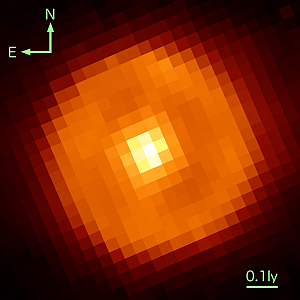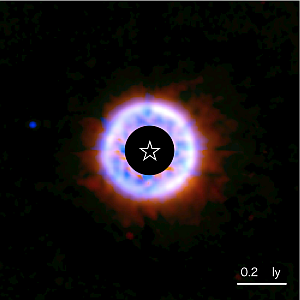AKARI Results
AKARI reveals Red Giants' dusty veils
AKARI reveals dusty veils enshrouding two Red Giant stars with unprecedented sensitivities and accuracies. The research would help to decipher the riddle of the cosmic reincarnation of matter surrounding the mystery of the origin of the basic chemical building blocks of life such as carbon.
AKARI is Japan's first autonomous infrared astronomical satellite launched in February 2006 by the Institute of Space and Astronautical Science/Japan Aerospace Exploration Agency. The new AKARI findings reveal dusty veils enshrouding two Red Giant stars, U Hydrae and U Antliae, with unprecedented sensitivities and accuracies. The dusty veils enveloping these Red Giant stars are made of the central stars' own material expelled as part of these dying stars' final throes. Because Red Giant stars are responsible for producing the majority of carbon in the universe, it is critical to understand how these old stars supply the universe with one of the most essential ingredients of life. After nearly 2 years of operation, AKARI collected detailed data from about 150 Red Giant stars and produced one of the deepest far-IR images of a shroud of dust surrounding Red Giant stars and made the first detection of it in the mid-IR. These new AKARI achievements have yielded crucial information as to when and how these dusty gaseous material has left the surface of the star and formed the circumstellar veils. The continuing AKARI investigations would help to decipher the riddle of the cosmic reincarnation of matter surrounding the mystery of the origin of the basic chemical building blocks of life such as carbon.
The research group consisting of astronomers associated with National Astronomical Observatory of Japan, University of Tokyo, and other institutes in Japan, USA, and UK[1] made observations of Red Giant stars of several billion years old known as U Hydrae and U Antliae, using the cutting-edge infrared instruments on-board AKARI. After one of the most detailed analyses ever made to these supreme data set, the research group has revealed the circumstellar dust shells around these two Red Giant stars in ways that have never been done before.
When stars like our Sun become very old, they would start to lose their surface material into the surrounding interstellar space. After this "mass loss" process Red Giant stars would eventually evolve to become Planetary Nebulae, which please the eyes of astronomy fans of all ages all around the world. This mass loss process is an important process for the final phases of the stellar evolution: however, the phenomenon is not well-understood and is still surrounded by lots of mysteries. The most recent studies indicate that mass loss does not continue to happen at a fixed constant rate but occurs intermittently. Such intermittent discharges of the surface material would generate multiple layers of stellar material, which can be observed in the infrared as warm/cold material surrounding the central star. Observations made by AKARI captured such layered structures of the circumstellar shells of Red Giant stars clearly and shed light on this mysterious "mass loss" phenomenon that takes place at the end of stars' life.
AKARI observations of the Red Giant star U Hydrae in the far-IR[2] show the beautifully round shape and geometrically thin structure of the circumstellar shell. This means that the expulsion of gas and dust from the star had happened isotropically (the same way in all directions) within a very short amount of time. It is estimated that the star had lost a 30-Earth mass worth of dust and a whopping 3000-Earth mass worth of gas in at most 100 years. This new finding appears to be consistent with past theoretical research, which suggests that such short intense expulsions of the surface material are caused by runaway thermonuclear fusion (called a thermal pulse or helium shell flash) that occurs deep within Red Giant stars periodically at intervals of tens of thousands of years. Meanwhile, the dusty stellar ejecta appear to be flowing off from the star into a specific direction, indicating that there is a flow of the interstellar medium around U Hydrae. The results of the AKARI investigations into U Hydrae will appear in the European Journal, Astronomy & Astrophysics, in April.
AKARI observations of the Red Giant star U Antliae in the far-IR have revealed the dust shell of the star in the mid-IR. This is the first detection ever made of such an extended dust shell in the mid-IR. Like U Hydrae, U Antliae shows the beautifully round structure of the circumstellar shell. This, too, is thought to be caused by a thermal pulse. Because of the higher spatial resolution achieved by the mid-IR imaging, the researchers were able to uncover the structure of U Antliae's dust shell in an unprecedented detail. By combining the mid-IR data and far-IR data (not shown here) of the dust shell, the temperature distribution within the dust shell has been calculated with the greatest reliability to date. The results of the analysis indicate that the dust shell is composed of two layers of dust having distinct temperatures and dust particle sizes. The masses of these dust layers have also been estimated with a greater accuracy: the inner layer's mass is worth 5 Moons and the outer layer's mass is worth 5 Earths. While it is still unclear as to why the dust shell has this two-layer construction, it is expected that this new finding will help deepen our understanding of the mass loss process from Red Giant stars. In future, researchers will be able to reveal the history of mass loss in many more Red Giant stars when such high spatial resolution mid-IR observations become routine. The results from the AKARI investigations into U Antliae have already been published in the American Journal, Astrophysical Journal Letters, on March 10, 2011.
This research group has been carrying out a project in which they systematically characterize the infrared properties of the Red Giant circumstellar dust shells to unveil the mysteries surrounding the mass loss process of evolved stars. The follow-up investigations to these findings are expected to further our understanding of the nature of these old Red Giant stars and of their roles in context of the chemical evolution of the universe.

Figure 1: A false-color far-IR image of U Hydrae at 90 micron taken with AKARI's Far-Infrared Surveyor (FIS), showing a shell of cold dust (45 degrees Kelvin = -228 ℃). This dust shell is seen in all far-IR bands of FIS at 65, 90, 140, and 160 microns. U Hydrae's far-IR dust shell is one of the brightest and most extended case ever observed, and therefore, is a very rare and valuable case in which the structures of the dust shell can be investigate in great detail. Subsequent numerical modeling has suggested that the dust shell has a hollow structure with a physically very thin wall. Such a thin dust shell is thought to have been produced by an intermittent mass loss.

Figure 2: A two-color-composite mid-IR image of U Ant taken with AKARI's Infrared Camera (IRC), showing a shell of warm dust (15 micron image in blue and 24 micron image in red; the central star has been subtracted and the central noisy region has been masked out for clarity; the position of the star is indicated by the "star" symbol). This is the first mid-IR image ever taken in which an extended detached dust shell around an evolved star has been captured. This image of the faint dust shell in the mid-IR was constructed successfully because bright emission from the central star was removed effectively through careful planning of observations and painstaking analysis of AKARI's high-quality data taken with its high-performance IRC instrument on-board the telescope.
- The research group consists of 13 researchers associated with various international institutions including National Astronomical Observatory of Japan, National Institutes of Natural Sciences (Okayama Astrophysical Observatory), Graduate School of Science, the University of Tokyo (Department of Astronomy, Institute of Astronomy, & Kiso Observatory), Institute of Space and Astronautical Science, Japan Aerospace Exploration Agency, University of Denver, Tohoku University Astronomical Institute, University College London, and Gunma Astronomical Observatory.
- While a far-IR image of U Hydrae has already been featured in a previous JAXA press release on August 28, 2006 ("AKARI unveils the birth and death of stars," http://www.jaxa.jp/press/2006/08/20060828_akari_e.html), the star is featured again in this release in light of significant discoveries made based on additional detailed observational data and analysis of them that were carried out after the observations of the star was completed.
Materials
- Figure 1 (© ISAS/JAXA)
- Figure 2 (© ISAS/JAXA)





